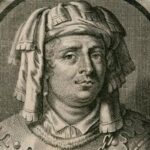
Date of Birth
610
Place of Birth
Landen, Liege, Belgium
Towns / Cities Moved Into
City One, Country | City Two, Country
Known Occupation
Abbedissa av Andenne
Religion
-
Death Information
Year of death
December 17, 693
Place of death
Heristal, Liege, BelgiumHeristal, Liege
Cause of death
-
Burial location
Saint Begga's Collegiate Church
Andenne, Arrondissement de Namur, Namur, Belgium
Obituary

Parents

Pepin 1er L'ancien De Landen

Itta Idoberge D' Aquitaine De Nivelles
Marital Status


Married Duke Maire du Palais Ansgise Margrave of Scheldt Ansgise
Siblings



Children





Narrative / Story
In the early 7th century, a remarkable woman named Begga de Landen was born in Landen, a region that is now part of Belgium. She was the daughter of Pepin of Landen, who held the important position of mayor of the palace, and St. Itta. Little did anyone know that Begga would grow up to become a saint and play a significant role in shaping the history of Europe.
Begga’s life was marked by significant events and challenges that were emblematic of the socio-economic issues of her time. The region where she was born and raised was under the rule of various Frankish leaders, and her family was influential in the political landscape. Despite her noble background, she faced discrimination and challenges that were common for women of her era. However, she defied societal norms and used her position to make a difference in the lives of others.
In 635, Begga married Anségisel Metz, the son of St. Arnulf of Metz, a prominent figure in the Frankish realm. Together, they had a son named Pepin of Herstal, who later founded the Carolingian dynasty, one of the most influential ruling families in European history.
After the death of her husband in 691, Begga’s life took a new direction. Driven by her faith and determination, she built a church and convent at Andenne on the Meuse River. This was a significant undertaking, and it showcased Begga’s dedication to religious and charitable works. She became the abbess of the convent and dedicated herself to a life of prayer, service, and leadership.
Begga’s actions were not without challenges. In a time of political turmoil and power struggles, she had to navigate the intricacies of the medieval world. The religious landscape was evolving, and Christianity was becoming more established. However, the region still had remnants of older pagan beliefs, and clashes between different religious practices were not uncommon.
Amid these challenges, Begga’s work as an abbess was instrumental in providing refuge and support to those in need. The convent she founded offered shelter and care to women, and her legacy of compassion and service inspired many.
Begga’s family lineage would eventually lead to her being the great-great-great-grandmother of the legendary Emperor Charlemagne, who would go on to shape the course of European history.
Life during Begga’s time was a blend of political intrigue, religious fervor, and societal changes. As a woman of nobility and a prominent religious figure, Begga experienced both the privileges and limitations that came with her position. She defied expectations by taking on leadership roles and contributing to her community in meaningful ways.
Throughout her life, Begga’s dedication to her faith and her commitment to helping others left a lasting impact on the people she encountered. Her feast day on December 17th is a reminder of the legacy of love, compassion, and service she left behind. Her story is not just that of a noblewoman, but of a trailblazer who used her influence to improve the lives of those around her during a time of great change and uncertainty.